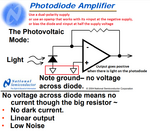Yarrrrr
Junior Member level 3
Hi, my first time posting here. I am a beginner at electronics.
I am building an optical guitar pickup, infrared diodes bouncing light onto the guitar strings back to photodiodes.
The circuit works but the signal to noise ratio makes it unusable, the latest design attempt uses parallel amplifiers with the hope of reducing noise but that didn't help at all. The final mounted part is wrapped in copper tape and grounded to shield from outside noise.
Components:
The op-amps are NE5532
IR Diode - TSUS5202
Photodiode - WL-TDRB Series
I'll attach schematics and a sound example of the current output.
Maybe there is some glaring mistake in there somewhere.
Audio:



I am building an optical guitar pickup, infrared diodes bouncing light onto the guitar strings back to photodiodes.
The circuit works but the signal to noise ratio makes it unusable, the latest design attempt uses parallel amplifiers with the hope of reducing noise but that didn't help at all. The final mounted part is wrapped in copper tape and grounded to shield from outside noise.
Components:
The op-amps are NE5532
IR Diode - TSUS5202
Photodiode - WL-TDRB Series
I'll attach schematics and a sound example of the current output.
Maybe there is some glaring mistake in there somewhere.
Audio:
Last edited:
